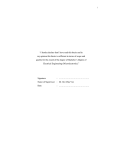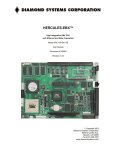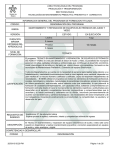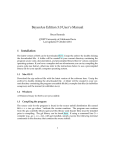Download Altera DE2-115 User manual
Transcript
My First FPGA for Altera DE2-115 Board 數位電路實驗 TA: 吳柏辰 Author: Trumen Outline • • • • • • • Complete Your Verilog Design Assign The Device Add a PLL Megafunction Assign the Pins Create a Default TimeQuest SDC File Compile and Verify Your Design Configuring the Cyclone IV E FPGA 2 Complete Your Verilog Design 3 exp1_traffic.v (1/5) module exp1_traffic ( clk, rst_n, pause, HEX0 ); It is a 10 seconds countdown system. module name = file name //==== parameter definition =============================== // for finite state machine parameter S_NORMAL = 1'd0; parameter S_PAUSE = 1'd1; // for countdown parameter C_PERIOD = 4'd9; //==== in/out declaration ================================== //-------- input --------------------------input clk; input rst_n; // reset signal (button) The countdown system can be input pause; // pause signal (switch) paused by turning on the switch. //-------- output -------------------------------------output [6:0] HEX0; 4 exp1_traffic.v (2/5) //==== reg/wire declaration ================================ //-------- output -------------------------------------Output should be register. reg [6:0] HEX0; (Critical path issue) //-------- wires --------------------------------------wire clk_16; // 16MHz clock signal wire [23:0] next_clks; reg next_state; reg [3:0] next_countdown; reg [6:0] next_HEX0; //-------reg [23:0] reg reg [3:0] flip-flops ---------------------------------clks; state; countdown; //==== combinational part ================================== // clock signal clksrc clksrc1 (clk, clk_16); assign next_clks = (state==S_PAUSE)? clks: clks+24'd1; PLL (input: clk, 50MHz) (output: clk_16, 16MHz) 5 exp1_traffic.v (3/5) // finite state machine (state) always@(*) begin case(state) S_NORMAL: begin if(pause==1) next_state = S_PAUSE; else next_state = S_NORMAL; end S_PAUSE: begin if(pause==1) next_state = S_PAUSE; else next_state = S_NORMAL; end endcase end Cover every possible branch of every if or case to avoid latches. // countdown always@(*) begin if(clks[23]==1'b1 && next_clks[23]==1'b0) 1Hz next_countdown = (countdown==0)? C_PERIOD: countdown-4'd1; else next_countdown = countdown; end Cover every possible branch. 6 exp1_traffic.v (4/5) // 7-segment Displays always@(*) begin case(countdown) 7'd0: next_HEX0 = 7'b1000000; 7'd1: next_HEX0 = 7'b1111001; 7'd2: next_HEX0 = 7'b0100100; 7'd3: next_HEX0 = 7'b0110000; 7'd4: next_HEX0 = 7'b0011001; 7'd5: next_HEX0 = 7'b0010010; 7'd6: next_HEX0 = 7'b0000010; 7'd7: next_HEX0 = 7'b1111000; 7'd8: next_HEX0 = 7'b0000000; 7'd9: next_HEX0 = 7'b0010000; default: next_HEX0 = 7'b1111111; endcase end Cover every possible branch. 7 exp1_traffic.v (5/5) //==== sequential part ===================================== always@( posedge clk_16 or negedge rst_n ) begin if( rst_n==0 ) begin clks <= 24'd0; state <= S_NORMAL; countdown <= C_PERIOD; HEX0 <= 7'h7f; end else begin clks <= next_clks; state <= next_state; countdown <= next_countdown; HEX0 <= next_HEX0; end end endmodule 8 Notepad++ (1/5) 1 2 3 Highlight 9 Notepad++ (2/5) 1 2 3 4 5 10 Notepad++ (3/5) Column Mode Editing 1. Alt + Mouse dragging 2. Alt + Shift + Arrow keys 11 Notepad++ (4/5) 1 4 3 2 12 Notepad++ (5/5) 13 Assign The Device 14 Introduction to FPGA (1/3) • A field-programmable gate array (FPGA) is an integrated circuit designed to be configured by a designer after manufacturing. • An electronic device is said to be fieldprogrammable if it can be modified "in the field". 15 Introduction to FPGA (2/3) • FPGAs contain programmable logic components called "logic blocks", and a hierarchy of reconfigurable interconnects that allow the blocks to be "wired together". • FPGAs can be used to implement any logical function that an ASIC could perform. 16 Introduction to FPGA (3/3) • Xilinx and Altera are the current FPGA market leaders and long-time industry rivals. • Both Xilinx and Altera provide free Windows and Linux design software (ISE and Quartus) 17 Altera's Main FPGA Products • Stratix series FPGAs are the largest, highest bandwidth devices, with up to 1.1 million logic elements. • Cyclone series FPGAs and are the company's lowest cost, lowest power FPGAs. • Arria series FPGAs are between the two device families above. 18 Altera® Development Kits http://www.altera.com/products/devkits/kit-dev_platforms.jsp • Development kits include software, reference designs, cables, and programming hardware (development board). 19 Installed The USB-Blaster driver (1/3) • Plug in the 12-volt adapter to provide power to the board. • Use the USB cable to connect the leftmost USB connector (the one closest to the power switch) on the DE2-115 board to a USB port on a computer that runs the Quartus II software. • Turn on the power switch on the DE2-115 board. USB cable 12-volt adapter power 20 Installed The USB-Blaster driver (2/3) • The computer will recognize the new hardware connected to its USB port. • But it will be unable to proceed if it does not have the required driver already installed. • The DE2-115 board is programmed by using Altera USB-Blaster mechanism. If the USB-Blaster driver is not already installed, the New Hardware Wizard will appear. • Next →Next →… →OK! 21 Installed The USB-Blaster driver (3/3) • If the New Hardware Wizard does not appear, check the website below ⇓ http://www.altera.com/download/drivers/usb-blaster/dri-usb-blaster-vista.html 22 Setup Licensing (1/2) 1 2 23 Setup Licensing (2/2) Only for IP 140.112.*.* 1 Make sure these items appear, and now you can compile your design. 24 2 Create a New Project 1 2 3 25 1 2 same as (top-level) file name 3 26 1 2 3 27 1 2 for DE2-115 3 28 29 3 2 1 4 30 1 2 3 31 Add a PLL Megafunction 32 Using Quartus Add a PLL Megafunction • A PLL uses the on-board oscillator (50 MHz for DE2-115 Board) to create a constant clock frequency as the input to the counter. • To create the clock source, you will add a prebuilt library of parameterized modules (LPM) megafunction named ALTPLL. 33 1 2 34 1 35 1 36 2 1 3 37 1 for DE2-115 2 3 38 Uncheck all the options 1 39 1 40 1 41 1 42 1 43 2 1 2 44 Assign the Pins 45 Assign the Pins • Before making pin assignments… 1 2 3 46 1 2 47 2 1 for DE2-115 Type “M23”, then push Enter 48 Now, you are finished creating your Quartus II design! Create a Default TimeQuest SDC File 49 Create a Default TimeQuest SDC File • Timing settings are critically important for a successful design. • For this tutorial you will create a basic Synopsys Design Constraints File (.sdc) that the Quartus II TimeQuest Timing Analyzer uses during design compilation. • For more complex designs, you will need to consider the timing requirements more carefully. 50 1 2 51 1 2 52 create_clock -period 20 [get_ports clk] create_clock -period 62.5 -name clk_16 derive_pll_clocks derive_clock_uncertainty set_input_delay 0 -clock clk_16 [all_inputs] set_output_delay 0 -clock clk_16 [all_outputs] If we do not use pll: create_clock -period 20 [get_ports clk] derive_clock_uncertainty set_input_delay 0 -clock clk [all_inputs] set_output_delay 0 -clock clk [all_outputs] 53 1 2 4 3 54 Compile and Verify Your Design 55 Compile Your Design • After creating your design you must compile it. • Compilation converts the design into a bitstream that can be downloaded into the FPGA. • The most important output of compilation is an SRAM Object File (.sof), which you use to program the device. 56 1 57 Compilation Report • Make sure there is no error. 58 Program the FPGA Device • After compiling and verifying your design you are ready to program the FPGA on the development board. • You download the SOF you just created into the FPGA using the USB-Blaster circuitry on the board. USB cable 12-volt adapter power 59 1 2 60 1 61 1 2 62 1 63 ~~Finish~~ 64 Demo Video • 10 seconds countdown system 65 Configuring the Cyclone IV E FPGA 66 Configuring the FPGA • JTAG programming In this method of programming, named after the IEEE standards Joint Test Action Group, the configuration bit stream is downloaded directly into the Cyclone IV E FPGA. The FPGA will retain this configuration as long as power is applied to the board; the configuration information will be lost when the power is turned off. • AS programming In this method, called Active Serial programming, the configuration bit stream is downloaded into the Altera EPCS64 serial configuration device. It provides non-volatile storage of the bit stream, so that the information is retained even when the power supply to the DE2-115 board is turned off. When the board's power is turned on, the configuration data in the EPCS64 device is automatically loaded into the Cyclone IV E FPGA. 67 JTAG Chain (1/2) • To use JTAG interface for configuring FPGA device, the JTAG chain on DE2-115 must form a close loop that allows Quartus II programmer to detect FPGA device. 68 JTAG Chain (2/2) • Shorting pin1 and pin2 on JP3 can disable the JTAG signals on HSMC connector that will form a close JTAG loop chain on DE2-115 board. Thus, only the on board FPGA device (Cyclone IV E) will be detected by Quartus II programmer. 69 Configuring the FPGA in JTAG Mode (1/2) • This figure illustrates the JTAG configuration setup. 70 Configuring the FPGA in JTAG Mode (2/2) 1. Ensure that power is applied to the DE2-115 board. 2. Configure the JTAG programming circuit by setting the RUN/PROG slide switch (SW19) to the RUN position. 3. Connect the supplied USB cable to the USB Blaster port on the DE2-115 board. 4. The FPGA can now be programmed by using the Quartus II Programmer to select a configuration bit stream file with the .sof filename extension. 71 Configuring the EPCS64 in AS Mode (1/2) • This figure illustrates the AS configuration setup. 72 Configuring the EPCS64 in AS Mode (2/2) 1. 2. Ensure that power is applied to the DE2-115 board. 3. Configure the JTAG programming circuit by setting the RUN/PROG slide switch (SW19) to the PROG position. 4. The EPCS64 chip can now be programmed by using the Quartus II Programmer to select a configuration bit stream file with the .pof filename extension. 5. Once the programming operation is finished, set the RUN/PROG slide switch back to the RUN position and then reset the board by turning the power switch off and back on; this action causes the new configuration data in the EPCS64 device to be loaded into the FPGA chip. Connect the supplied USB cable to the USB Blaster port on the DE2-115 board. 73 Programmer Object File • Programmer Object File is a binary file (with the extension .pof) containing the data for programming a configuration device. • A Programmer Object File for a configuration device can be generated by the Convert Programming Files command (File menu). 74 1 for DE2-115 3 7 4 8 2 5 6 9 75 1 2 3 4 5 76 2 1 77 ~~Finish~~ 78 The End. Any question? Reference 1. http://en.wikipedia.org/wiki/Fieldprogrammable_gate_array 2. "My First FPGA for Altera DE2-115 Board" by Terasic Technologies Inc. 3. "DE2-115 User Manual" by Terasic Technologies Inc. 80
























































































